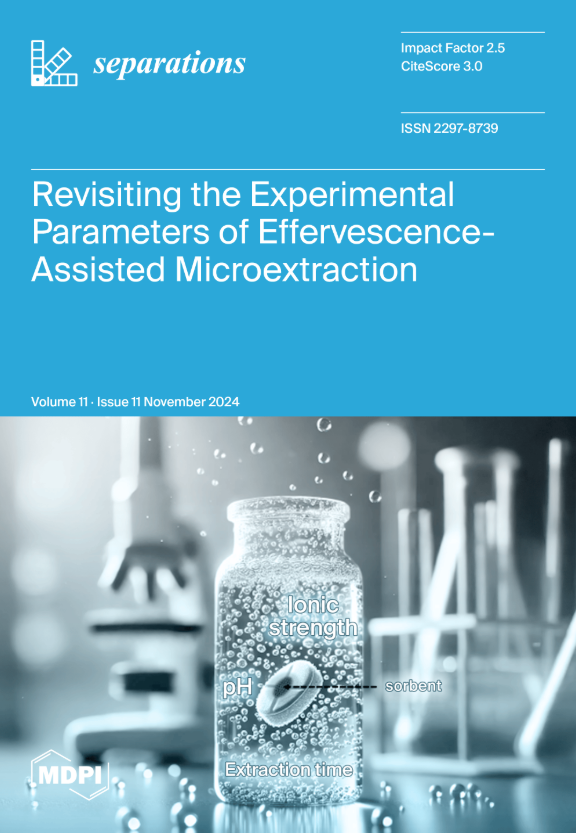利用不同的纳米颗粒提高水泥砂浆固定工业废水中硫酸盐的效率
IF 2.7
4区 工程技术
Q3 CHEMISTRY, ANALYTICAL
引用次数: 0
摘要
处理工厂排放的工业废水(IWW)是环境领域的一个重要课题,而使用水泥基材料是处理含有意外离子的材料的有效方法。本研究利用从工厂收集的含有大量 SO42- 的废水制备水泥砂浆(IWWCM),并使用三种纳米材料(NMs),包括纳米二氧化硅(NS)、纳米碳酸钙(NC)和纳米高岭土(NMK)来改善 IWWCM 的性能。研究了试样的抗压强度、水化程度、水化产物和微孔结构。试验结果表明,IWW 降低了试样的强度,而使用 NMs 可以补偿强度的降低。具体而言,淡水(FW)混合试样的 28 天强度为 44.6 兆帕,使用 IWW 后,该值降至 41.8 兆帕。然而,使用无机材料的试样强度均高于 50 兆帕,这表明无机材料在 IWWCM 强度方面具有优势。此外,IWWCM 的水化程度较低,孔隙结构较差,而在 IWWCM 中使用 NM 可改善这些特性,从而提高试样的强度。SO42- 含量测量结果还表明,使用 NMs 可以提高 SO42- 结合率,这有利于缓解工业工厂处理 IWW 的压力。本文章由计算机程序翻译,如有差异,请以英文原文为准。
Improving the Efficiency of Cement Mortar to Immobilize Sulfate in Industrial Wastewater Using Different Nanoparticles
The disposal of industrial wastewater (IWW) discharged from factories is a significant topic in the environment field, and the use of cement-based materials is a useful way to treat materials with unexpected ions. In this work, IWW with abundant SO42− collected from a factory was utilized to prepare cement mortar (IWWCM), and three kinds of nanomaterials (NMs), including nano-SiO2 (NS), nano-CaCO3 (NC), and nano-metakaolin (NMK), were used to improve the performance of IWWCM. The compressive strengths, hydration degree, hydration products, and micropore structure of the specimens were investigated. The test results showed that IWW reduced the strength of the specimens, and the use of NMs could compensate for this strength reduction. To be specific, the 28-day strength of the freshwater (FW) mixed specimen was 44.6 MPa, and the use of IWW decreased this value to 41.8 MPa. However, the strengths of the specimens with NMs were all higher than 50 MPa, indicating the advantage of NMs for the strengths of the IWWCMs. Moreover, the IWWCM showed a lower hydration degree with a poor pore structure, whereas the use of NMs in IWWCMs refined these properties, explaining the strength increase in the specimens. The results of the SO42− content measurements also showed that the use of NMs could improve the SO42− binding ratio, which is conducive to relieving the pressure of IWW disposal for industrial factories.
求助全文
通过发布文献求助,成功后即可免费获取论文全文。
去求助
来源期刊

Separations
Chemistry-Analytical Chemistry
CiteScore
3.00
自引率
15.40%
发文量
342
审稿时长
12 weeks
期刊介绍:
Separations (formerly Chromatography, ISSN 2227-9075, CODEN: CHROBV) provides an advanced forum for separation and purification science and technology in all areas of chemical, biological and physical science. It publishes reviews, regular research papers and communications. Our aim is to encourage scientists to publish their experimental and theoretical results in as much detail as possible. There is no restriction on the length of the papers. The full experimental details must be provided so that the results can be reproduced. There are, in addition, unique features of this journal:
Manuscripts regarding research proposals and research ideas will be particularly welcomed.
Electronic files and software regarding the full details of the calculation and experimental procedure, if unable to be published in a normal way, can be deposited as supplementary material.
Manuscripts concerning summaries and surveys on research cooperation and projects (that are funded by national governments) to give information for a broad field of users.
The scope of the journal includes but is not limited to:
Theory and methodology (theory of separation methods, sample preparation, instrumental and column developments, new separation methodologies, etc.)
Equipment and techniques, novel hyphenated analytical solutions (significantly extended by their combination with spectroscopic methods and in particular, mass spectrometry)
Novel analysis approaches and applications to solve analytical challenges which utilize chromatographic separations as a key step in the overall solution
Computational modelling of separations for the purpose of fundamental understanding and/or chromatographic optimization
 求助内容:
求助内容: 应助结果提醒方式:
应助结果提醒方式:


